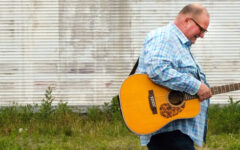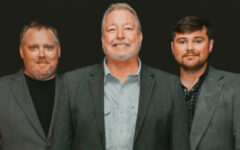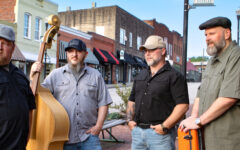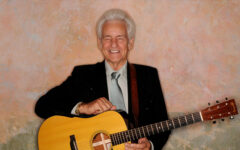This review was written by John McGann, Associate Professor of Strings at the Berklee College Of Music in Boston, MA.
 A wise friend of mine once observed that "people spend a lot of energy looking for what something isn’t, rather than what something is." Punch is an adventurous listener’s paradise and an acoustic music lover’s dream. Led by composer/mandolinist/lead vocalist Chris Thile with Chris Eldridge (guitar/vocal), Noam Pikelny (banjo/vocal), Gabe Wichter (fiddle/vocal) and Greg Garrison (bass/vocal), the Punch Brothers deliver an astonishing range of styles and moods with relaxed virtuosity across three songs, an instrumental, and an innovative 40 minute four movement suite.
A wise friend of mine once observed that "people spend a lot of energy looking for what something isn’t, rather than what something is." Punch is an adventurous listener’s paradise and an acoustic music lover’s dream. Led by composer/mandolinist/lead vocalist Chris Thile with Chris Eldridge (guitar/vocal), Noam Pikelny (banjo/vocal), Gabe Wichter (fiddle/vocal) and Greg Garrison (bass/vocal), the Punch Brothers deliver an astonishing range of styles and moods with relaxed virtuosity across three songs, an instrumental, and an innovative 40 minute four movement suite.
The touchstones of established styles on this recording span many genres: a classical range of tone colors and dynamics, from quiet filigree to ominous thunder; a jazz sense of adventure, harmonic daring and "sound of surprise;" the blue grass drive and commitment to the groove; the pop songwriter’s flare for melody, and the progressive rock musician’s restless penchant for shifting textures and colors. While echoes of the above styles combine with and extend the groundbreaking New Acoustic work of the Trischka-Grisman-Flecktones-Newgrass vectors, it is fair to say that the band is breaking new ground and creating its own unique idiom. It is not merely "chamber music" played with bluegrass instrumentation, but music conceived to take advantage of the traditional bluegrass band instrumentation as presented to the world by Bill Monroe in 1945, albeit in ways Mr. Monroe may never have imagined.
Compositionally, there are definite parallels with classical music in the "through composed" long form style of composition (particularly in the four movement suite The Blind Leaving The Blind) rather than the more typical verse/chorus song form’s repeated sections. The creative use of counterpoint and counter melodies as well as contrasts and combinations of instrumental colors between musical lines are more the stuff of the classical orchestrator, rather than the bluegrass arranger. Independent rhythmic interplay creates clockwork-like textures at various times that mesh like a bluegrass band, dixieland group, and chamber orchestra (and sometimes all three at once!). Of course, along with the carefully composed mosaics of counter lines, we find improvisational passages that depend on the unique personalities of each band member to be realized, much in the way that jazz legend Duke Ellington relied on his stable of players to create the music’s character.
The band sought, and achieved, a live-in-the-studio sound and vibe, with a very three dimensional stereo mix. The production quality of this recording is wonderful. The word "transparent" comes to mind, as a very light hand was used in the application of reverb – indeed, if any was added, since the music was recorded in a 4600 square foot room. In fact, the sonic picture was created by using three overhead mics, much the way a traditional string quartet would be recorded.
Punch Bowl leads off the album, the initial melody creating a definite old-time vibe which quickly takes a darker turn as dissonant chords accompany a tried and true bluegrass theme ‚Äì let’s call it an updated Dim Lights Thick Smoke and Loud Loud Music ‚Äì delivered with dangerous edges intact. In fact, the entire album is a modern True Life Blues, particularly the recording’s centerpiece The Blind Leaving the Blind which follows.
Lyrically, the piece follows the recent breakup of Chris’ marriage in a style he calls "anecdotal, conversational, and episodic." In less imaginative hands, this kind of material has the potential to fall into the zone of treacly confessional singer-songwriter audience-as-analyst zone. Somehow, this soul-bearing avoids wallowing in self-pity, and emerges at the end, singed but not burnt. I love how this music changes gears so many times, yet there is always the feeling of flow from section to section, and no Frankenstein-style parts-assembly feeling. The composition feels as organic as the sound quality.
Sometimes follows, a beautiful instrumental that vacillates between bluegrass terrain and more open textures.
Nothing Then reprises the relationship-gone-bad theme with an insistent pulse that dissolves into a cloud and the final track, It’ll Happen is a lovely, soothingly tonal waltz that ends the album on a decidedly optimistic note.
As with all music of substance, more will be revealed upon repeated listening. I believe that those who can hear it for what it is will be rewarded with a thrilling journey through not only a variety of musical styles, but also emotions – a combination of despair, humor, bitterness and finally, hopefulness.







